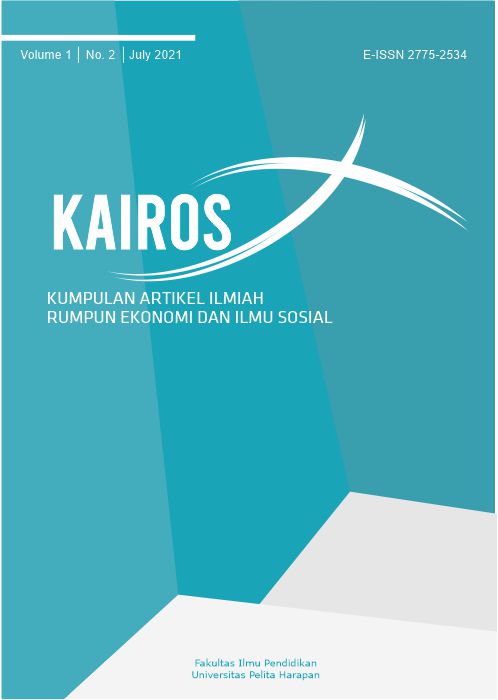INOVASI PEMBELAJARAN KOMPUTER DAN MEDIA PEMBELAJARAN BAGI MAHASISWA LAMBAN BELAJAR [COMPUTER AND LEARNING MEDIA INNOVATION FOR STUDENTS WITH LEARNING DISABILITIES]
DOI:
https://doi.org/10.19166/kairos.v1i2.3982Kata Kunci:
learning innovation, computers and learning media, inovasi belajar, komputer dan media pembelajaran, mahasiswa lamban belajar slow learner,Abstrak
The Faculty of Education has students from all regions in Indonesia who have diverse academic and socio-cultural backgrounds. This reality has impacted the learning process during lectures and the quality of the resulting teacher candidates. The IQ test result and the student's cumulative grades showed that some of the students struggled in participating in the learning process and were also categorized as slow learners. An effort is needed to accommodate the needs of these students in the classroom setting. This study aims at implementing a learning innovation for slow learners in Computer and Learning Media courses. The research used the descriptive qualitative method. This study showed that curriculum modifications and additional teaching materials and tutorials enabled slow learners to pass their Computer and Learning Media course. This program has produced an instructional design model that accommodates slow learner students' needs in the learning process.
ABSTRAK BAHASA INDONESIA: Mahasiswa Fakultas Ilmu Pendidikan yang berasal dari seluruh daerah di Indonesia mempunyai latar belakang kemampuan akademik dan sosial budaya yang beragam. Hal ini berdampak dalam proses pembelajaran selama mengikuti perkuliahan dan kualitas luaran calon guru yang dihasilkan. Hasil IQ dan data nilai memperlihatkan bahwa masih ada mahasiswa yang mengalami kesulitan dalam mengikuti pembelajaran atau disebut sebagai mahasiswa lamban belajar. Perlu suatu upaya untuk mengakomodasi para mahasiswa yang masuk dalam kategori lamban belajar dalam pembelajaran di kelas. Tujuan penelitian ini adalah menerapkan inovasi pembelajaran bagi mahasiswa lamban belajar pada mata kuliah Komputer dan Media Pembelajaran. Metode penelitian yang digunakan adalah deskriptif kualitatif. Melalui modifikasi kurikulum dan materi bahan ajar yang dilengkapi dengan tutorial, membuktikan bahwa mahasiswa lamban belajar pada akhirnya dapat lulus pada mata kuliah Komputer dan Media Pembelajaran. Program ini telah menghasilkan rancangan model pembelajaran yang dapat mendukung pembelajaran mahasiswa berkebutuhan khusus dengan kesulitan lamban belajar.
Referensi
Arikunto, S. (2005). Dasar-dasar evaluasi pendidikan. Jakarta: Bumi Aksara.
Ashman, A. F., & Elkins, J. (2005). Educating children with diverse abilities. Melbourne: Pearson/Prentice Hall
Bank Indonesia. (2011). Perekonomian Indonesia tahun 2010. Jakarta, Indonesia: Bank Indonesia.
Fennema-Boom, J. R. (2009). Code-scaffolding: A pedagogic code-switching technique for bilingual content instruction. The Journal of Education,190(3), 27-35. https://doi.org/10.1177/002205741019000304
Gerke, S. (2000). Global lifestyles under local conditions: The new Indonesian middleclass. In B.H. Chua (Eds.). Consumption in Asia: Lifestyle and identities (pp. 135-158). New York, NY: Routledge.
Hennessey, M. N., Higley, K., & Chesnut, S. R. (2012). Persuasive pedagogy: A new paradigm for mathematics education. Educational Psychology Review, 24(2), 187-204. https://doi.org/10.1007/s10648-011-9190-7
Kebudayaan, D. P.-L. P. D. K. P. dan K. (2009). Pedoman Umum Penyelenggaraan Pendidikan Inklusif (Sesuai Permendiknas No 70 Tahun 2009).
Lewis, G. R., & Demarest, B. A. (1996). Integrative theology. Grand Rapids, MI: Zondervan Publishing House.
Makulloluwa, E. (2013). Code switching by teachers in the second language classroom. International Journal of Arts & Sciences, 6(3), 581-598. Retrieved from https://universitypublications.net/ijas/0603/pdf/T3N299.pdf
Pratiwi, J. (2015). Sekolah inklusi untuk anak berkebutuhan khusus: tanggapan terhadap tantangan kedepannya. Prosiding Seminar Nasional Pendidikan, 1(2), 237-242. Retrieved from http://jurnal.fkip.uns.ac.id/index.php/pip/article/download/7725/5551
Salend, S. J. (2016). Creating Inclusive Classrooms: Effective, differentiated, and reflective practices. Upper Saddle River, NJ: Pearson.
Sousa, D. A. (2016). How the special needs brain learns (3rd ed.). Thousand Oaks, CA: Corwin.
Van Brummelen, H. (2008). Batu loncatan kurikulum: berdasarkan alkitab. Jakarta, Indonesia: Pelita Harapan University Press.
Vasudevan, A. (2017). Slow learners: causes, problems and educational programmes. International Journal of Applied Research, 3(12), 308-313. Retrieved from https://www.allresearchjournal.com/archives/2017/vol3issue12/PartE/3-11-79-891.pdf
Widyastuti, R.S. (2011, January 14). Masih sebatas macan kertas. Kompas, 34.
Unduhan
Diterbitkan
Cara Mengutip
Terbitan
Bagian
Lisensi
Hak Cipta (c) 2021 Wiputra Cendana, Budi Wibawanta, Year Rezeki Patricia Tantu, Keren Hapkh Watulingas

Artikel ini berlisensiCreative Commons Attribution-ShareAlike 4.0 International License.
Authors who publish with this journal agree to the following terms:
1) Authors retain copyright and grant the journal right of first publication with the work simultaneously licensed under a Creative Commons Attribution License (CC-BY-SA 4.0) that allows others to share the work with an acknowledgement of the work's authorship and initial publication in this journal.
2) Authors are able to enter into separate, additional contractual arrangements for the non-exclusive distribution of the journal's published version of the work (e.g., post it to an institutional repository or publish it in a book), with an acknowledgement of its initial publication in this journal.
3) Authors are permitted and encouraged to post their work online (e.g., in institutional repositories or on their website). The final published PDF should be used and bibliographic details that credit the publication in this journal should be included.




